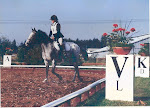
There has been much attention of late to riding bridleless. I must say at the outset, DO NOT TRY THIS AT HOME. Communicating with your horse without headgear is a technique that riders can use only when they learn to sit still at all gaits, learn to give the cue for any movement EXACTLY the same each time, and practice the maneuver hundreds, no, thousands of times.
I do want to have you think about the idea that less is more. Take for instance, the snaffle bit. What a mild, safe bit in the hands of novices and experienced riders alike. This is what we are led to believe. I would like to take this opportunity to say that this is NOT SO. Radiographic images of the horse's mouth show the following. click here
Let us examine the snaffle bit action on the horse's mouth. Click on the following excerpt from MC Diamond Ranch, tack sellers: http://www.mcdiamond.com/bitinformation.htm
There is a common myth that all bits with broken mouthpieces are snaffles and vice versa. Snaffles can be of "straight bar" design, such as with this old heavy horse driving bit. Additionally some leverage bits have broken mouthpieces and therefore are not snaffles.
Horses have a variety of differently shaped mouths. The mouthpiece needs to be long enough to fit in the horse's mouth without pinching the lips, but not overly long where it will shift back and forth excessively. Additionally, some horses have rather flat pallets and they may need a flatter profile, 3-piece mouthpiece (one where the bar is "broken" in two places).
The headstall should be adjusted so that the snaffle hangs comfortably in the horse's mouth, not so sloppy that it bumps the horse's teeth and not so tight that it applies uncomfortable pressure against the corners of the mouth. Generally if the snaffle pulls one to two mild wrinkles back against the corner of the mouth, the snaffle will maintain a comfortable position.
The part about the palate of the horse is an important detail most people overlook. It is necessary before choosing a bit to examine you horse's mouth and tongue and teeth. Often a horse that is having a hard time giving to the bit is actually in pain or discomfort. Take you snaffle bit and hold the mouthpiece in one hand, then putt on the bit rings with your other hand. As you will see, the mouthpiece turns into a V. the point of the V actually pokes into the palate or top of the horse's mouth. Although popular belief is that the snaffle actually works on the lips and tongue of the horse, the palate action is what makes the horse flex his head to get the pointy V off the palate.
How many of you have seen people pull hard on one rein and then the other (see saw) through the horse's mouth to get him to stop or give? Imagine running the snaffle joint rapidly across your lips and tongue with those jointed rings in the middle pinching your tongue. The bridleless people contend that without the bit, the horse is more relaxed and has less want to fight pressure. This much we know is true. Although I do not advocate everyone going bridleless, I do wish people would train a horse for the least stimulus needed and not run to grab a more severe bit when the horse is not responding. There is no substitute for using the release and learning timing to teach any horse to stop without the bit pressure. Watch Stacy Westfall in my previous post ride a reining pattern with no tack at all. Note that the horse is licking its lips, carrying its own head and stops with no pressure at all on the mouth. Now we know that a bit was used in the beginning, but now the reins do not need to be touched.
I was only able to muster up the courage to go bridleless with one horse I had in training. It is an awesome feeling to communicate with sign language, the seat and legs and weight cues. I have not had a horse long enough since then to try again until now. I bought a Kentucky Mountain horse who had probably been ill trained, then turned out as a brood mare. She is extremely afraid of any touch on the reins and will set her head in the bridle and run away. She has no turn or stop when she gets adrenalized like that, so I have my work cut out for me. The mare rides best with no saddle and with a side-pull or S-hackamore.


We work in the barn aisle or small enclosure and practice walking free headed, stopping and turning and stopping and turning. I am careful to only give pressure when I want to move the feet, or if it relates to what I want the feet to do.
I will talk more about that in my upcoming weekly series, "The Making of Molly", a video blog or vlog about how to start an older horse (17) under saddle for the first time. I hope to begin that series in March, as soon as I learn to make podcasts and use my new digital video camera.
But I digress. Back to a bit about bits. I will probably do a weekly "bit" on bitting choices and alternatives, so tune in every Monday. Next week: The Truth about TOM THUMB bits!!!








No comments:
Post a Comment